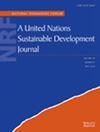中国水资源调峰的三支柱分析:探索资源利用与产业结构的相互作用
IF 3.7
4区 社会学
Q2 ENVIRONMENTAL SCIENCES
引用次数: 0
摘要
本研究从 "石油峰值 "和 "碳峰值 "理论中汲取灵感,提出了水峰值理论这一创新概念。运用环境库兹涅茨曲线、塔皮奥脱钩理论和对数均值除法指数分解法,分析了 2006 年至 2020 年的数据,得出了重要结论。首先,中国三次产业的水资源利用结构失衡,需要将第一产业的水资源重新分配到第二产业和第三产业。其次,尽管中国尚未达到用水绝对峰值,但面临着可持续发展的困境。第三,第一产业和第二产业的用水量与经济增长脱钩,而第三产业在实现历史用水峰值方面面临挑战。第四,生产方面的驱动因素(技术效应、结构效应、产出效应)大幅降低了所有行业的用水量,有助于实现用水峰值。相反,消费方面的因素(人口效应)作用较小,潜力尚未开发。这项研究为世界各国确定水资源管理的历史拐点、寻求工业用水和经济增长的可持续途径、实现环境质量和可持续经济发展目标提供了宝贵的见解。中国的经验可作为这方面工作的指导范例。本文章由计算机程序翻译,如有差异,请以英文原文为准。
Water peaking with a three‐pillar analysis in China: Exploring the interplay of resource utilization and industrial structure
This study introduces the innovative concept of water‐peaking theory, drawing inspiration from the theories of “peak oil” and “carbon peaking.” Employing the Environmental Kuznets Curve, Tapio's decoupling theory, and Logarithmic Mean Divisia Index decomposition, we analyze data spanning from 2006 to 2020, yielding significant findings. First, China's three industries exhibit an imbalanced structure in the utilization of water resources, necessitating the reallocation of water from the primary industry to the secondary and tertiary industries. Second, although China has not yet attained absolute water peaking, it confronts a predicament in sustainable development. Third, the primary and secondary industries demonstrate favorable decoupling of water consumption from economic growth, while the tertiary industry faces challenges in achieving historical water peaking. Fourth, drivers on the production side (technological effects, structural effects, output effects) substantially reduce water consumption across all industries, contributing to progress toward water peaking. Conversely, factors on the consumer side (population effects) play a minor role with untapped potential. This research provides valuable insights for nations worldwide in identifying historical inflection points in water resource management, pursuing sustainable pathways for industrial water usage and economic growth, and achieving environmental quality and sustainable economic development objectives. China's experiences serve as a guiding exemplar in this endeavor.
求助全文
通过发布文献求助,成功后即可免费获取论文全文。
去求助
来源期刊

Natural Resources Forum
环境科学-环境科学
CiteScore
6.10
自引率
0.00%
发文量
24
审稿时长
>36 weeks
期刊介绍:
Natural Resources Forum, a United Nations Sustainable Development Journal, focuses on international, multidisciplinary issues related to sustainable development, with an emphasis on developing countries. The journal seeks to address gaps in current knowledge and stimulate policy discussions on the most critical issues associated with the sustainable development agenda, by promoting research that integrates the social, economic, and environmental dimensions of sustainable development. Contributions that inform the global policy debate through pragmatic lessons learned from experience at the local, national, and global levels are encouraged.
The Journal considers articles written on all topics relevant to sustainable development. In addition, it dedicates series, issues and special sections to specific themes that are relevant to the current discussions of the United Nations Commission on Sustainable Development (CSD). Articles must be based on original research and must be relevant to policy-making.
Criteria for selection of submitted articles include:
1) Relevance and importance of the topic discussed to sustainable development in general, both in terms of policy impacts and gaps in current knowledge being addressed by the article;
2) Treatment of the topic that incorporates social, economic and environmental aspects of sustainable development, rather than focusing purely on sectoral and/or technical aspects;
3) Articles must contain original applied material drawn from concrete projects, policy implementation, or literature reviews; purely theoretical papers are not entertained.
 求助内容:
求助内容: 应助结果提醒方式:
应助结果提醒方式:


